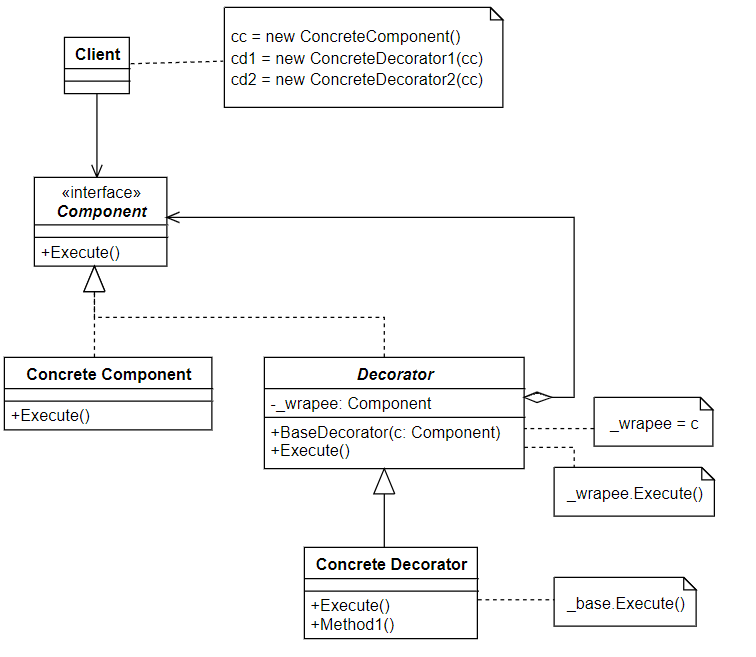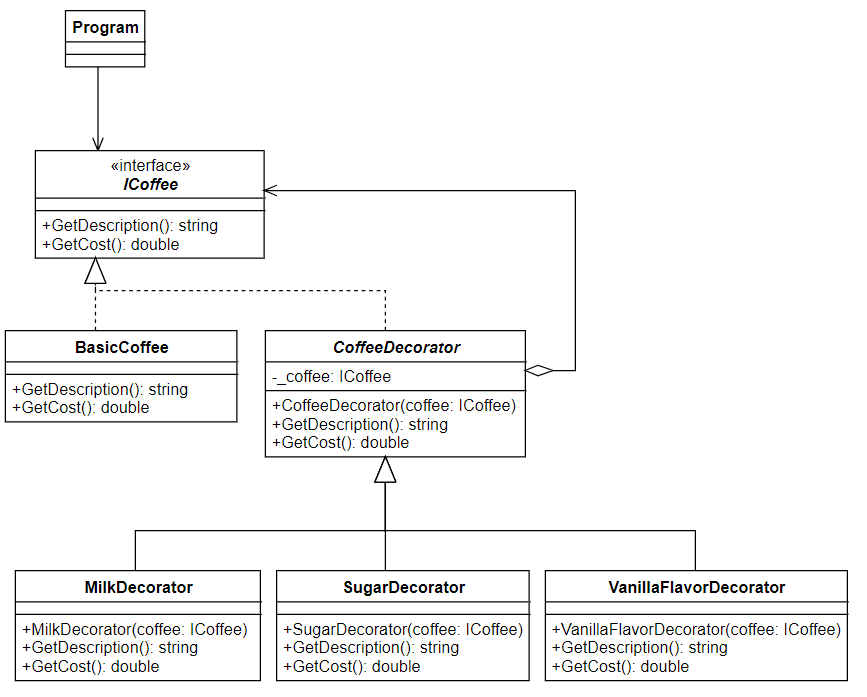As software developers, we all want to write code that is easy to maintain, scalable, and efficient. However, as software projects get increasingly complex, maintaining clean and efficient code becomes challenging. Here, the Decorator Design Pattern types comes into play.
The Decorator Design Pattern is a structural pattern that allows adding new functionality to an existing object without altering its original class. This pattern involves wrapping the original object in a decorator class, which has the same interface as the object it decorates. The decorator class then adds its behavior to the object during runtime, allowing for increased flexibility and modularity in programming.
So, in simpler terms, the Decorator Design Pattern enables the dynamic extension of an object’s behavior. This article will explore how the Decorator Design Pattern works and when to use it.

How does the Decorator Design Pattern work
The Decorator Design Pattern consists of four main components: the Component interface, the Concrete Component class, the Decorator abstract class, and the Concrete Decorator class.

The Component interface defines the methods or properties that both the object (Concrete Component) and its decorators (Concrete Decorator) will implement. It ensures that the decorators conform to the same interface as the object they decorate.
The Concrete Component is the object we want to decorate (enhance or modify). It implements the Component interface, providing the basic functionality.
The Decorator is an abstract class or interface that implements the Component interface. It acts as a base class for all Concrete Decorators. It contains a reference to a Component object and can add new or modify existing behavior by delegating calls to the underlying Component. Decorators are stackable, meaning we can add multiple decorators to an object.
The Concrete Decorator is the decorator class, extending the Decorator base class. Each Concrete Decorator adds specific functionality or behavior to the object. They override methods from the Component interface and may call the corresponding method on the Component they wrap.
Here is a step-by-step explanation of how the Decorator Design Pattern works: How do you use a decorator design pattern?
- We start with a Concrete Component, which is our base object.
- We create Concrete Decorator classes that inherit from the Decorator and implement the same Component interface. These classes contain the additional behavior we want to add to the object.
- When we want to enhance the original object, we wrap it with one or more Concrete Decorators. Each Decorator takes the original object as a parameter and delegates the calls to the original object while adding its behavior as needed.
- We can stack multiple decorators to combine various behaviors. These decorators can be added or removed dynamically during runtime.
- The Client code interacts with the decorated object as if it were the original one, unaware of the decorators’ presence. The decorators transparently extend the object’s functionality.
Now, let us look at a real-world inspired example: we will model a coffee ordering application, where we will have a base coffee object. We can use decorators to add extra features to the coffee, such as adding milk, sugar, whipped cream, or flavorings. Each decorator modifies the cost or taste of the coffee without changing the core coffee class.

In this example, we have BasicCoffee as the Concrete Component, and we use decorators to add features such as milk, sugar, and vanilla flavor. The decorators modify the description and cost of the coffee. The client code demonstrates how to create a customized coffee order with various combinations of decorators..
The source code for the presented sample is available on GitHub.
Advantages of the Decorator Design Pattern:
The Decorator Design Pattern offers several advantages in software development, making it a valuable tool for extending and enhancing the functionality of objects. Some of the key advantages include:
- Open-Closed Principle: The Decorator pattern adheres to the Open-Closed Principle, which means that we can extend the functionality of objects without modifying their source code. This promotes code stability and reduces the risk of introducing new bugs when adding new features.
- Flexibility and Extensibility: Decorators provide a flexible way to add or remove features dynamically at runtime. We can stack multiple decorators to achieve different combinations of behavior, allowing for fine-grained customization of objects.
- Reusability: Decorators are reusable components. Once we create a decorator for a specific functionality, we can apply it to different objects without duplicating code. This promotes code reusability and minimizes code redundancy.
- Single Responsibility Principle: Each decorator class has a single responsibility, which makes the code more maintainable and easier to understand. This aligns with the Single Responsibility Principle (SRP), one of the SOLID principles of object-oriented design.
- Transparency: Decorators are designed to be transparent to the client code. Clients interact with the decorated objects as if they were the original ones. This simplifies client code and improves the overall user experience.
- Granular Control: We can apply decorators selectively to add specific features. This fine-grained control allows us to add only the required functionality, reducing the risk of overcomplicating an object.
- Promotes Composition over Inheritance: The Decorator pattern is an excellent alternative to class inheritance for extending object behavior. It avoids the issues associated with deep class hierarchies and the diamond problem, which can occur in languages that support multiple inheritance.
- Maintains Object Structure: The Decorator pattern preserves the structure of the original object, ensuring that it remains recognizable. This makes it easier to manage and debug code.
- Supports Legacy Code Integration: Decorators can be applied to existing classes or legacy code without significant modifications. This is particularly useful when working with codebases that cannot be easily refactored.
- Separation of Concerns: By breaking down behavior into smaller, focused decorators, we can separate different concerns or aspects of an object’s functionality. This separation makes the codebase more organized and easier to maintain.
- Improved Testing: Since decorators are small, focused components, they can be unit-tested in isolation, which enhances the testability of our code.
Despite these advantages, it is essential to use the Decorator pattern judiciously. Overuse of decorators can lead to code complexity and make the system harder to understand. It is important to balance flexibility and simplicity, applying the pattern where it provides clear benefits.
Disadvantages of the Decorator Design Pattern
While the Decorator Design Pattern offers many advantages, it also has some disadvantages and considerations to keep in mind:
- Complexity and Nesting: Overuse of decorators can lead to a complex hierarchy, making it challenging to understand the overall structure and relationships among decorators and the base component. It can result in “decorator soup” or a convoluted class hierarchy.
- Increased Number of Classes: Implementing decorators for multiple features can result in many classes. This can make the codebase more extensive and harder to manage, especially if there are numerous combinations of decorators.
- Maintenance Overhead: Managing decorators and their interactions can become complex and lead to increased maintenance overhead. Adding or modifying decorators may require careful consideration to avoid unintended consequences.
- Performance Overhead: Each decorator introduces a level of method delegation, which can lead to a minor performance overhead. If performance is a critical concern in our application, the use of decorators should be evaluated carefully.
- Limited to Interface Inheritance: The Decorator pattern relies on interface inheritance, which means that it can only extend the behavior of objects through interfaces or abstract classes. It cannot add new data members to the original object.
- Limited Support for Removing Decorators: While we can add decorators dynamically, removing them is not as straightforward. If we need to remove a specific decorator from an object, it may require additional logic or a separate mechanism.
- Potential for Unintended Behavior: If decorators are not designed carefully, they can lead to unintended behavior or conflicts between decorators. Ensuring that decorators do not interfere with each other requires careful planning and testing.
- Incompatibility with Some Classes: Not all classes are suitable for the Decorator pattern. It works best when the base component and decorators conform to a shared interface or base class. If the base class is sealed or does not have a suitable interface, applying the Decorator pattern can be challenging.
- Complex Object Initialization: Constructing decorated objects can be more complex, involving multiple steps to attach the appropriate decorators. This can make object initialization less straightforward compared to creating objects without decorators.
- Alternative Design Patterns: In some cases, other design patterns like the Composite pattern or Strategy pattern may provide a more natural and efficient solution for the problem at hand.
- Increased Code Volume: The Decorator pattern can result in increased code volume due to the need to create multiple decorator classes and interfaces, potentially making the codebase harder to manage.
Despite these disadvantages, the Decorator pattern remains a valuable tool in many situations where dynamic, flexible extension of object behavior is required. Careful design, planning, and adherence to best practices can help mitigate some of the potential downsides. It is important to weigh the benefits against the drawbacks and consider alternative design patterns when appropriate.
When should we use the Decorator Design Pattern?
The Decorator Design Pattern is a valuable tool for extending and enhancing the functionality of objects, but it is not always the best choice for every situation. Here are some scenarios in which we should consider using the Decorator pattern:
- Adding Features Dynamically: Use the Decorator pattern when we need to add new features or behavior to an object at runtime without altering its original class. This is particularly useful when dealing with complex, evolving systems.
- Avoiding Class Explosion: When we have a class hierarchy with many subclasses, and each subclass represents a combination of options, decorators can help avoid the proliferation of classes and simplify the codebase.
- Open-Closed Principle: If we want to follow the Open-Closed Principle, which encourages extending functionality without modifying existing code, the Decorator pattern is a good fit. It allows us to extend objects while keeping their source code unchanged.
- Fine-Grained Customization: When we require fine-grained control over the behavior of an object and want to add or remove specific features selectively, decorators offer granular customization.
- Reusability: If we anticipate the need to apply the same feature to multiple objects or reuse specific functionality across different parts of our application, decorators promote code reusability.
- Transparency: When it is essential that the client code interacts with objects consistently, decorators maintain transparency by ensuring that clients can treat decorated objects as if they were the original objects.
- Legacy Code Integration: The Decorator pattern can be applied to existing classes, even in legacy code, making it an excellent choice when we need to introduce new functionality without refactoring large portions of the codebase.
- Complex Combinations of Behavior: When we need to combine different features or behaviors in complex ways, decorators allow us to build these combinations step by step, keeping the code manageable.
- Separation of Concerns: If we want to separate different concerns or aspects of an object’s functionality into distinct components for better organization and maintainability, the Decorator pattern helps achieve this separation.
- Unit Testing: Decorators can be unit-tested in isolation, making them suitable for codebases emphasizing unit testing and quality assurance.
However, there are situations where the Decorator pattern may not be the best choice:
- Static and Simple Behavior: If an object’s behavior is simple and unlikely to change, and there is no need for dynamic extensions, using decorators might introduce unnecessary complexity.
- Performance Considerations: Adding multiple decorators to an object can introduce a slight performance overhead due to the method delegation involved. If performance is a critical concern, we should evaluate the impact carefully.
- Complexity: Overusing decorators can lead to a complex web of decorators, making the code harder to understand and maintain. In such cases, other design patterns or refactoring may be more appropriate.
Ultimately, the decision to use the Decorator pattern should be based on the specific requirements of our project. It is a powerful pattern when applied judiciously to address the need for dynamic and flexible extensions of objects while preserving code integrity.
Real-world examples of Decorator Design Pattern
The Decorator Design Pattern is widely used in software development for extending the functionality of objects’ functionality flexibly and reusable. Here are some real-world examples where we might find the Decorator pattern in action:
- Input/Output Streams: For example, we can have a FileInputStream or a FileOutputStream as a base component, and then we can add various decorators like BufferedInputStream, GZIPOutputStream, or DataInputStream to enhance or modify the behavior of these streams without altering the core classes.
- Graphic Libraries: In graphic libraries, decorators add features to graphical components. For instance, we can have a basic graphical component (e.g., window) and then use decorators to add functionality such as borders, scrollbars, or tooltips. Also, we can use decorators for adding features to widgets, like adding mouse-over effects, tooltips, or custom styling.
- Text Formatting: In text processing applications, we can have a basic text formatter that formats plain text. Decorators can add formatting options like bold, italics, underline, or different fonts to the text without modifying the original text formatter class.
- Dynamic Web Page Generation: In web development, we can use decorators for generating dynamic web pages. We can have a base page class and use decorators to add features like headers, footers, navigation menus, or authentication checks. This allows us to create different page variations with a combination of decorators.
- Authentication and Authorization: In security systems, decorators can add authentication and authorization checks to various components of an application. For example, we can have a base service, and then decorators can be applied to restrict access to that service based on user roles or permissions.
- Logging and Monitoring: In logging and monitoring systems, decorators can be applied to add logging, error handling, or performance monitoring to various components without altering the core functionality of those components.
- Vehicle Configurators: In a vehicle configurator application, we can have a base vehicle object, and decorators can add options like sunroofs, leather seats, upgraded stereo systems, and more, allowing users to build custom configurations.
These real-world examples demonstrate how the Decorator Design Pattern can be applied to enhance the functionality of objects while keeping the core classes unchanged and promoting code reusability and flexibility.
Conclusion
The Decorator Design Pattern promotes a flexible and maintainable way to enhance and extend the behavior of objects without the need to modify their core classes. It adheres to the Open-Closed Principle, which encourages software entities (classes, modules, etc.) to be open for extension but closed for modification. This pattern is beneficial when we need to add functionality to objects in a granular and reusable manner. However, it should be employed with careful consideration of the potential complexities and overhead it may introduce to our software architecture.








